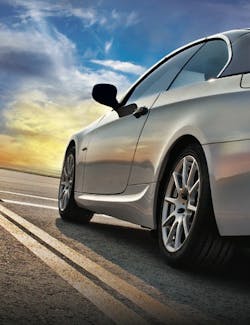When it comes to designing touring tires, auto manufacturers drive the trends. But what is a touring tire, exactly? Tire manufacturers have differing points of view on categorizing this evolving tire segment.
Auto manufacturers have been telling tire makers that customers want more versatility out of their vehicles. They want all-season capability, including snow traction, plus they demand great handling and long tread life. They want all that with low noise and high ride comfort, too.
Is that what a touring tire is? Is the definition subject to change? To find out, we asked touring tire manufacturers these questions:
“How would you define a touring tire? Do you expect this definition to change in the next few years?”
Fifteen tire manufacturers responded. They are: Bridgestone Americas Tire Operations LLC, Continental Tire the Americas LLC, Cooper Tire & Rubber Co., Falken Tire Corp., GITI Tire (USA) Ltd., Goodyear Tire & Rubber Co., Hankook Tire America Corp., American Kenda Rubber Industrial Co. Ltd. (which does business as Kenda USA), Kumho Tire USA Inc., Maxxis International, Michelin North America Inc., Nexen Tire America Inc., Pirelli Tire North America Inc., Sentury Tire Americas and Yokohama Tire Corp.
For the private brand perspective on defining touring tires, visit www.moderntiredealer.com for exclusive content.
Anant Gandhi, product manager, Bridgestone: A touring tire provides users with balanced handling along with a quiet, comfortable ride and good tread wear. The majority of touring tires sold in North America are all-season tires, which also offer an acceptable level of light snow traction.
Recently, there has been more emphasis placed on improved fuel efficiency without any other performance trade-offs. I expect this trend to continue over the next few years.
Joe Maher, passenger and winter tire product manager, Continental: There is no standard definition of touring tires. The most common definition is “touring tires are for drivers who prefer long wear, a smooth quiet ride and predictable handling.”
Touring tires are most commonly S or T speed rated (with) aspect ratios 60 series and higher. Most touring tires in the U.S. are all-season for use in light snow conditions.
We predict this definition will remain the same except for the trend to higher speed ratings (i.e., H and V) and lower aspect ratios — 50 and 55 series. This trend is led by OE vehicle manufactures... H- and V-rated come OE on minivans and even 50 series T-rated tires are standard (on some) consumer vehicles.
Scott Jamieson, director of product management, Cooper: The basic definition of a touring tire is a tire designed to provide a smooth, quiet, comfortable ride with all-season capability. A touring tire generally provides an equal balance of performance for drivers and driving habits. A touring tire will not necessarily target one specific area of performance, such as maximum dry cornering grip like a UHP tire. I don’t anticipate the definition of a touring tire will change, but some of the performance expectations may change, such as the speed rating. Traditionally, it was believed that only T-rated tires were considered touring, but as the performance of touring vehicles has evolved, so has the high speed requirements.
Rick Brennan, executive director of product strategy, Falken: Touring has been a catch-all category for anything that wasn’t a performance tire. If it didn’t have a directional tread and it wasn’t a wild and crazy tread pattern, then it fit into the touring tire category. Everything now is either a touring tire or a performance tire, in reality.
When you stop and look at tread designs, you can look at tires being sold as touring tires that aren’t a traditional straight rib. Touring today is anything that people are going to mount on their cars, use every day, and expect long mileage, good ride comfort and low noise.
I don’t expect the definition of a touring tire to change because they’re not really defined today. If you ask 10 different people what a touring tire is, they’ll give you 10 different specific answers. If you stick with good ride comfort, long mileage, low noise, decent all-season (and) overall commuter-type tire use, that’s what a touring tire is today, and I think it’s going to stay that way.
[PAGEBREAK]
David Shelton, director of product marketing, GITI: The touring tire has definitely changed over the past few years and will continue to shift in the future. Historically, this category was one focusing on comfort, and the tires were S or T speed rated. The key was ride comfort, low noise and good uniformity to provide vehicle occupants with a nice highway cruise and long tire life for the owner.
Today and for the future, more and more vehicles are using H- and V-rated tires, yet the consumers still expect a quiet comfortable ride. They expect a balance of performance plus ride, comfort and mileage.
Mike Markoff, category manager, high performance tires, Goodyear: The industry defines a touring tire as a tire with design emphasis on driver comforts such as ride and noise.
Good handling is present, but not expected to be the primary attribute. In some cases, the traditional touring tire is being challenged to perform more like a sport tire while not sacrificing the noise and ride comfort.
Shawn Denlein, senior vice president of sales, Hankook: The RMA defines “touring” as a tire that focuses on comfort and ride performance and has an S or T speed rating. This definition will most likely change in the coming years. Touring tires are typically what have been provided as OE fitments in the past.
Recently, however, vehicle manufacturers have asked for increased performance for their original equipment fitments, including H-, V- and W-rated OE tires.
Bob Phoenix, vice president of automotive sales, Kenda: A touring tire is a step up from a traditional passenger radial tire in comfort or performance, or both. Whether the definition of a touring tire changes or remains the same, touring tires will continually evolve.
John Mosby, product planning coordinator, Kumho: A touring tire is one that combines sporty handling with a high level of ride comfort, low noise and long mileage. It is a well-rounded tire that performs in all areas rather than excelling in any one area while lacking in others.
We may see a move toward slightly sportier touring tires in the next few years, but a big change in touring tire characteristics is unlikely.
Scott Slemmons, senior sales representative, Maxxis: A touring tire is a premium tire designed to provide longer tread life, combined with a smooth quiet ride. Most touring tires are all-season rated, which provides improved wet and dry road traction.
The definition should remain the same, although there are now tires on the market being called “super touring” and “grand touring” that generally have better high performance characteristics than a traditional touring tire.
Jim Knowles, original equipment expert, Michelin: Touring tires typically have a lower profile and wider tread than prior generation standard-type tires. They are primarily designed to provide improved handling without any appreciable loss of the ride comfort qualities typical of standard tires.
Touring tires have lower aspect ratios than standard tires, with many having larger rim diameters.
Kyle Roberts, director of marketing, Nexen: A touring tire is typically constructed to maximize comfort and keep noise levels low.
Recently, we have seen the expectation of touring tires trend towards higher mileage, and we expect this trend to continue for the next few years.
Stephen Ewing, business intelligence manager, Pirelli: A touring tire is one that is focused on providing the highest level of ride comfort and the most mileage rather than focusing primarily on performance attributes.
I expect this distinction to stay in place as the product segments target distinctly different consumer demographics.
Maxwell Wee, director of sales, Sentury: Touring tires fill the gap between standard PCR and UHP tires. Touring tires are generally wider (the tread) and have a lower profile, plus a higher speed rating, than PCR but offer a smoother ride, are quieter and offer more comfort than UHP tires.
Robert Abram, product planning manager, Yokohama: Touring tires have a design meant to blend the handling and sporty feel of a performance tire with the comfort and tread life of a passenger tire. A dramatic change from that base definition isn’t expected, but as the touring market has evolved into higher speed ratings, terms like grand touring or performance touring have been used to describe touring tires where the aforementioned blend of performance and comfort leans more toward the performance side.
Our Avid Ascend is a great example. We tackled performance and mileage with our optimized orange oil compound, as well as addressed more performance oriented fitments with a richer mix of H- and V-rated sizes and lower profiles. ■



